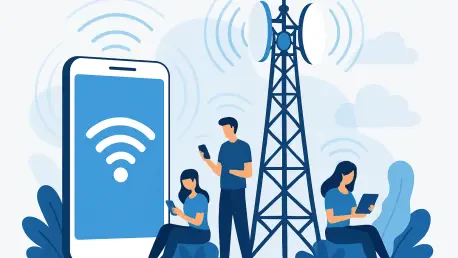In an era where seamless mobile connectivity is no longer a luxury but a fundamental need, the Liverpool City Region Combined Authority has embarked on a pioneering initiative to transform digital access across its key areas. Imagine attending a vibrant event like the Southport Flower Show, only to find that poor signal strength prevents sharing those colorful moments online or even coordinating with friends. This frustration is all too common in certain pockets of the region, often referred to as “not-spots,” where connectivity falters. Recognizing this challenge, the authority launched a project to map mobile coverage in granular detail, using innovative technology mounted on everyday municipal vehicles. The goal is to create a publicly accessible, interactive map that highlights signal strengths and weaknesses, ultimately improving communication for residents, businesses, and visitors alike. This ambitious effort not only addresses immediate connectivity issues but also sets a benchmark for digital infrastructure in the UK.
Revolutionizing Connectivity with Smart Mapping
The Liverpool City Region’s approach to enhancing mobile coverage stands out for its ingenuity and practicality. By equipping garbage trucks and street sweepers with signal scanners, the project captures data on connectivity at a street-by-street level for major UK providers like EE, O2, and Vodafone across 4G and 5G networks. Launched earlier this year, this method leverages existing municipal resources to gather comprehensive information without incurring significant additional costs. The resulting interactive map, freely available to the public, serves as a vital tool for identifying areas with poor signal, known as not-spots, and enables informed decisions about provider selection. Beyond urban streets, the initiative extends to iconic locations such as Victoria Park, home of the Southport Flower Show, and Aintree Racecourse, ensuring that even high-traffic visitor attractions are covered. This data-driven strategy highlights a commitment to bridging digital gaps in both everyday settings and during major events, fostering a more connected community.
Complementing the vehicle-based surveys, the project incorporates hands-on efforts to assess coverage in areas inaccessible by road. Volunteers equipped with portable signal detection units conduct walking surveys in places like beaches, pedestrian paths, and bustling shopping centers. High-demand scenarios, such as Ladies Day at the Grand National festival at Aintree or the River of Light event, are specifically targeted to evaluate network performance under pressure. These meticulous surveys provide critical insights into both coverage and capacity, revealing how networks hold up when thousands of users are online simultaneously. The data collected helps pinpoint exact locations where improvements are needed, ensuring that future enhancements are both targeted and effective. This blend of technology and community involvement showcases an adaptable model that other regions could emulate, addressing connectivity challenges with precision while prioritizing the needs of diverse environments across the Liverpool area.
Enhancing Visitor Experiences at Iconic Attractions
Reliable mobile coverage has become a cornerstone of successful event management and visitor satisfaction at major attractions in the Liverpool City Region. Alan Adams, General Manager of the Southport Flower Show, emphasizes that a strong signal is indispensable for coordinating large-scale events, ensuring safety, and facilitating communication between organizers, staff, and emergency services. Equally important is the ability for attendees to engage digitally, whether by sharing photos or navigating event apps in real time. Poor connectivity can disrupt these interactions, diminishing the overall experience and potentially compromising safety protocols. By mapping coverage at venues like Victoria Park, the initiative directly tackles these concerns, providing data that can guide network upgrades. This focus on digital reliability reflects a broader understanding that connectivity is integral to modern public gatherings, transforming how events are planned and enjoyed in the region.
Similarly, expansive attractions like Knowsley Safari, spanning 550 acres with a five-mile drive, face unique connectivity challenges that impact visitor enjoyment. Jon Turley, the General Manager, notes that identifying coverage gaps is crucial for maintaining satisfaction, especially as guests often wish to share memorable moments like selfies with wildlife instantly online. Weak signals in remote park areas can frustrate these expectations, underscoring the need for comprehensive network mapping. The project’s efforts at Knowsley Safari and other sites, such as BrewDog Stadium in St Helens, aim to ensure seamless communication across vast and varied terrains. By addressing these specific not-spots, the initiative not only enhances individual experiences but also supports the region’s visitor economy, which relies heavily on positive impressions and word-of-mouth promotion. This targeted approach demonstrates a nuanced understanding of how digital access shapes perceptions of iconic destinations.
Building a Digitally Connected Future
Cllr Liam Robinson, Cabinet Member for Innovation at the Liverpool City Region, views this mapping project as a strategic step toward positioning the area as the UK’s most digitally connected region. The benefits extend beyond mere convenience, impacting residents, local businesses, and the thriving visitor economy by providing actionable data for network improvements. The interactive map serves as a practical resource, helping individuals choose suitable mobile providers and aiding event planners in anticipating connectivity needs. This forward-thinking vision aligns with broader goals of digital inclusion, ensuring that no corner of the region is left behind in the push for better infrastructure. By addressing both daily communication needs and the demands of major attractions, the initiative lays a foundation for sustained economic growth and community engagement, setting a precedent for how technology can solve real-world challenges.
Reflecting on the strides made, the Liverpool City Region’s efforts mark a significant milestone in tackling mobile coverage gaps with a blend of innovation and practicality. The use of municipal vehicles and volunteer surveys provides a cost-effective way to gather detailed data, directly benefiting high-profile venues and everyday users alike. Stakeholders, from event managers to regional leaders, unite in their recognition of reliable connectivity as a vital component of safety, coordination, and engagement. Looking ahead, the insights gained offer a clear path for network providers to prioritize upgrades in identified not-spots. Future considerations include expanding the mapping scope to additional areas and refining data collection techniques to keep pace with evolving network technologies. This initiative not only addresses immediate connectivity hurdles but also inspires a blueprint for other regions striving to enhance digital access, ensuring that the benefits of a connected society reach all corners of the community.









